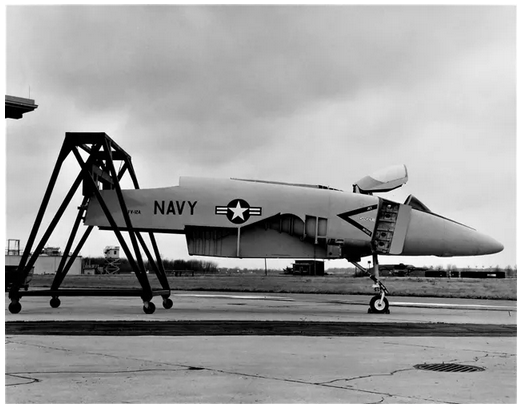US XFV-12 vertical takeoff and landing fighter jet
In the 1970s, US Secretary of Operations Elmer Zumwalt proposed the concept of the Sea Control Ship (SCS), which can be seen as a modern upgraded version of World War II escort aircraft carriers. It mainly carries anti submarine helicopters and vertical takeoff and landing fighter jets, and is paired with four escort ships to form an anti submarine task force. It can be dispatched to patrol various oceans on a daily basis, withdraw to the rear to make way for main aircraft carriers during wartime, and undertake escort and other tasks on its own.

The XFV-12 carrier based vertical takeoff and landing fighter is a carrier based aircraft developed for naval vessels. It was developed by Rockwell Corporation and requested by the US Navy in 1972. The company completed a full-scale wind tunnel model in 1974 and began ground testing in 1977, which was a bit fast for a new aircraft. The first prototype was the XFV-12A, which had high development costs and risks. In order to control costs, the designers used the nose of the A-4 attack aircraft and the intake of the F-4 Phantom. The fighter abandoned the vertical takeoff and landing technology of the British Harrier fighter jet's belly jet and instead adopted wing blowing technology. The prototype adopts a duck wing layout, with trapezoidal wings and a large angle sweep angle on the main wing. The main wing tip is equipped with a vertical tail, and the upper part of the vertical tail is slightly inclined outward. Both the duck wing and the main wing are equipped with large louvered ailerons. During vertical takeoff and landing, the engine tail nozzle is closed, and the engine gas is transferred to the wing surface through pipelines. By adjusting the ailerons, the thrust direction is changed to achieve upward lift.

The prototype is a single pilot aircraft, equipped with one 20mm cannon and four air-to-air missiles for air combat, which can be "Sparrow" or "Rattlesnake". Although its force value is lower, considering that it is only a carrier based aircraft for making sea vessels and does not participate in the battles of the main fleet, it can provide basic air superiority competition needs for its fleet. According to the designer's calculations, the fighter jet is powered by a Pratt&Whitney F401-PW-400 jet engine, which theoretically can achieve a maximum flight speed of 2.2-2.4 Mach. However, it is quite awkward during vertical takeoff and landing. Although the maximum takeoff weight of the fighter jet is only 11 tons, with an empty weight of about 6260 kilograms, it is not very heavy, similar to the Harrier vertical takeoff and landing fighter jet. However, its different lift system cannot generate enough lift and can only provide 75% of the force required for flight, making it impossible to fly. This prototype only underwent partial experiments, and the results proved that it could perform conventional takeoff and landing and flight except for not being able to take off and land vertically, but its speed was not as fast as expected.

The company originally built two prototypes, but the second one was not fully completed due to cost increases. The US Navy completely terminated the XFV-12 development project in 1981, so there was no further development. In fact, there is another important reason why the navy gave up on it, which is that they have shifted their focus to amphibious assault ships and no longer develop naval vessels. Naturally, there is no need to continue developing supporting equipment, and the navy can directly purchase the British Harrier type carrier based vertical takeoff and landing fighter.The XFV-12, like the sea going ship, was an exploration of technology and concept by the US Navy. It was born in the era of bipolar confrontation at that time, but it has been proven that this technological approach is not very practical, and no country has conducted similar research and development to this day.
Source: Military of Strong Countries